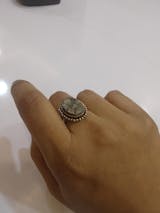Introduction to Pyrite
Pyrite, also known as Fool's Gold, is a fascinating mineral that has captured the attention of humans for centuries. Its brassy yellow color and metallic luster make it visually reminiscent of gold, hence the name Fool's Gold. Pyrite is composed of iron sulfide and is commonly found in sedimentary rocks.
Pyrite has a rich history and has been used for various purposes throughout time. Its unique properties and striking appearance have made it a popular subject of fascination, both in the scientific community and among those interested in metaphysical and spiritual practices. In this post, we shall look at the different uses of pyrite.
The Legends of Fool's Gold
Pyrite's resemblance to gold has given rise to numerous legends and tales throughout history. In ancient times, people would often mistake pyrite for real gold, leading to disappointment when they discovered its true nature. This led to the term "Fool's Gold" as a way to describe something that appears valuable but is actually not.
Despite its deceptive appearance, pyrite holds its own unique allure. It has been associated with wealth, prosperity, and abundance, leading to its use in various metaphysical and spiritual practices. Many believe that pyrite has the power to attract money and abundance into one's life. To learn more about the metaphysical properties of pyrite, visit our article on pyrite metaphysical properties.
Throughout the ages, pyrite has also found its place in jewelry and ornaments. Its sparkling golden hue and metallic shine make it an attractive gemstone. Pyrite has been used in ancient jewelry, both as a standalone gemstone and as an accent alongside other precious stones. Even today, pyrite continues to be popular in jewelry designs, adding a touch of elegance and sophistication. To explore more about pyrite in jewelry, head over to our article on pyrite jewelry.
Pyrite's uses extend beyond its aesthetic appeal. Its unique properties have made it valuable in various industrial applications. From sulfur production to steel manufacturing and even use in batteries, pyrite plays a significant role in these industries. To delve deeper into the industrial applications of pyrite, continue reading our article on pyrite uses.
As we unravel the uses and significance of pyrite, we will explore its various applications in industrial, jewelry, metaphysical, and scientific realms. Pyrite's versatility and captivating properties make it an intriguing mineral that continues to captivate both scientists and enthusiasts alike.
Pyrite in Industrial Applications
Pyrite, also known as fool's gold, has found its place in various industrial applications due to its unique properties. Let's explore some of the key uses of pyrite in industries.
Sulfur Production
One of the significant applications of pyrite is its role in sulfur production. Pyrite contains sulfur, and through a process called roasting, sulfur can be extracted from pyrite. The sulfur obtained from pyrite is essential for the production of sulfuric acid, a vital compound used in various industries, including fertilizers, chemical manufacturing, and wastewater treatment.
Steel Manufacturing
Pyrite plays a role in steel manufacturing as a source of sulfur. Sulfur, when added to steel, improves its machinability and enhances certain properties. Pyrite, with its sulfur content, can be used as a source of sulfur in the steelmaking process.
Use in Batteries
Pyrite has also found its application in the production of batteries. Pyrite can be used as a cathode material in certain types of batteries, such as lithium-ion batteries. Its abundance and relatively low cost make it an attractive option for battery manufacturers.
The table below summarizes the industrial applications of pyrite:
| Industrial Application | Description |
| Sulfur Production | Extraction of sulfur from pyrite for sulfuric acid production |
| Steel Manufacturing | Source of sulfur for improving steel properties |
| Batteries | Cathode material in certain types of batteries |
Pyrite's versatility and unique properties make it a valuable resource in various industrial sectors, contributing to the production of essential materials and products.
Pyrite in Jewelry and Ornaments
Pyrite, also known as "Fool's Gold," has been valued for centuries for its captivating appearance and versatility. Its unique metallic luster and golden hue make it a popular choice for jewelry and ornaments. Let's explore how pyrite is used in this context.
Pyrite as Gemstone
Pyrite is often cut and polished into various gemstone shapes, including faceted gemstones or cabochons. The glittering surface of pyrite gemstones resembles that of gold, giving them an alluring appeal. These gemstones may be used in various jewelry pieces, including pyrite rings, pyrite necklaces, pyrite earrings, and pyrite bracelets.
In addition to its visual appeal, pyrite is thought to have metaphysical properties that make it attractive among those seeking positive energy and abundance. It is believed to enhance confidence, creativity, and manifestation. For more information on the metaphysical properties of pyrite, you can read our article on pyrite metaphysical properties.
Pyrite in Ancient Jewelry
Pyrite has a rich history in the world of crystal jewelry, dating back to ancient times. It has been found in archaeological sites across various civilizations, including ancient Greece, Rome, and Egypt. In these cultures, pyrite was used to create intricate jewelry pieces such as amulets, pendants, and beads. It was often associated with wealth, prosperity, and protection.
Ancient jewelers would mix pyrite with other gemstones and metals to make magnificent jewelry pieces. The combination of pyrite with materials like silver, gold, or other colored gemstones enhanced its beauty and significance.
Pyrite as Decorative Material
Beyond jewelry, pyrite is also used as a decorative material in various ornamental objects. Its distinctive golden hue and metallic shine make it an excellent choice for decorative items such as sculptures, figurines, and home decor accents. Pyrite is often incorporated into interior design elements to add a touch of elegance and natural beauty to living spaces.
The use of pyrite as a decorative material extends to other areas as well. It can be found in architecture, where it is used in the construction of buildings or incorporated into mosaics and other intricate designs. Pyrite's unique appearance and durability make it a versatile choice for adding a touch of sophistication to both personal and public spaces.
In summary, pyrite's captivating beauty and metallic luster make it a sought-after choice for jewelry and ornamental purposes. Whether used as gemstones in various jewelry pieces, incorporated into ancient artifacts, or utilized as a decorative material, pyrite continues to captivate with its timeless allure.
Pyrite in Metaphysical and Spiritual Practices
Beyond its industrial and ornamental uses, pyrite holds a special place in metaphysical and spiritual practices. This section explores how pyrite is believed to bring wealth and prosperity, provide protection and grounding, and its role in crystal healing.
Pyrite for Wealth and Prosperity
Pyrite is often associated with attracting wealth and prosperity. Its golden color and metallic luster have led to its reputation as "Fool's Gold," symbolizing abundance and good fortune. Many believe that carrying or wearing pyrite can help manifest financial success and opportunities.
In metaphysical practices, pyrite is said to stimulate the solar plexus chakra, which is associated with personal power and manifestation. By aligning with this energy center, pyrite is believed to enhance confidence, motivation, and the ability to attract abundance into one's life.
Pyrite for Protection and Grounding
Pyrite is also valued for its protective and grounding pyrite properties. It is believed to shield against negative energies and psychic attacks, creating a protective barrier around the aura. This protective quality is said to promote mental clarity, emotional stability, and a sense of security.
In spiritual practices, pyrite is often associated with the root chakra, which governs stability, grounding, and connection to the physical world. By working with pyrite, individuals seek to strengthen their foundation, establish a sense of security, and remain grounded amidst life's challenges.
Pyrite in Crystal Healing
In the realm of crystal healing, pyrite is cherished for its unique healing properties. It is believed to have a revitalizing effect on the body and mind, promoting overall well-being. Pyrite is thought to enhance vitality, boost energy levels, and improve focus and concentration.
Pyrite is also believed to support emotional healing by promoting positive thinking, self-confidence, and a sense of empowerment. Some practitioners use pyrite to alleviate anxiety, depression, and fatigue, helping individuals regain a sense of inner strength and resilience.
Incorporating pyrite into crystal healing practices can involve placing pyrite crystals on the body, using pyrite-infused oils, or meditating with pyrite to tap into its energetic properties.
By harnessing the metaphysical and spiritual properties of pyrite, individuals seek to tap into its energy to enhance their lives. Whether it's attracting wealth, providing protection, or promoting emotional and physical well-being, pyrite plays a significant role in these practices. It's important to note that these beliefs and practices are rooted in spirituality and personal experiences.
Pyrite in Science and Education
Pyrite, with its distinctive golden sheen, has found its way into various scientific and educational settings. Let's explore how pyrite is used as a teaching tool, its role in geology studies, and its importance in research and experiments.
Pyrite as a Teaching Tool
Pyrite's unique properties make it an excellent teaching tool in educational settings. Its metallic luster and cubic crystal structure make it visually appealing for students to observe and study. Teachers often use pyrite specimens to demonstrate crystal formation and symmetry. By examining pyrite samples, students can gain a better understanding of mineral identification and crystallography.
In addition to its crystal structure, pyrite's golden color and metallic properties provide a tangible example for discussions on mineral properties and their classification. Students can learn about the physical and chemical characteristics of pyrite, such as its hardness, streak, and specific gravity. These hands-on experiences with pyrite contribute to a deeper understanding of geology and earth sciences.
Pyrite in Geology Studies
Geologists rely on pyrite to decipher the Earth's history and understand geological processes. Pyrite's presence in sedimentary rocks, metamorphic rocks, and even fossils provides valuable clues about the conditions in which these formations were created. By studying the distribution and abundance of pyrite, geologists can gain insights into past environments, such as ancient oceans, marshes, or volcanic systems.
Pyrite's formation conditions and its association with other minerals and rocks are also subjects of interest in geology studies. Researchers investigate the formation process of pyrite, the conditions under which it crystallizes, and its occurrence in different geological settings. These investigations contribute to a greater understanding of the Earth's geological history.
Pyrite in Research and Experiments
Beyond its role in education and geology studies, pyrite is also utilized in various research and experimental applications. Scientists explore the properties and behavior of pyrite to gain insights into its electronic structure, magnetic properties, and catalytic capabilities. Pyrite's unique properties make it a subject of interest in fields such as materials science, nanotechnology, and environmental research.
Researchers have also conducted experiments to understand pyrite's reactivity with other substances and its potential applications in areas such as energy storage, water treatment, and electrochemistry. These experiments help expand our understanding of pyrite's versatility and its potential contributions to scientific advancements.
By utilizing pyrite as a teaching tool, studying its presence in geological formations, and exploring its properties in research and experiments, scientists and educators continue to uncover the remarkable aspects of this captivating mineral.















